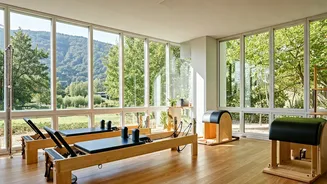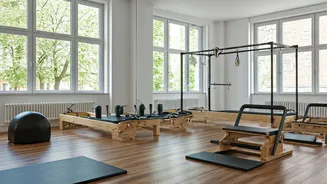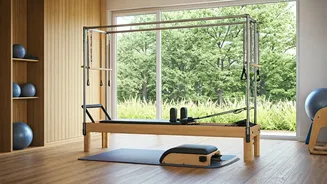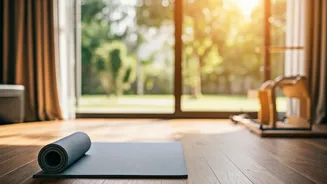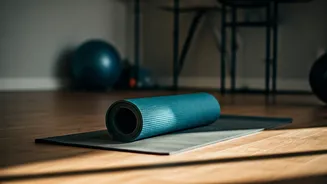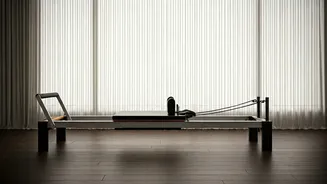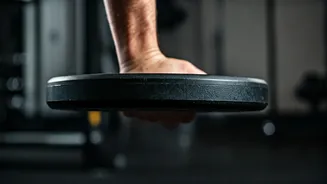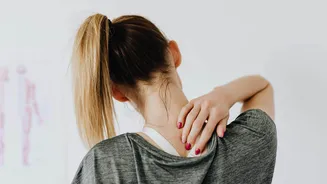Pilates vs Gym
Comparing Pilates with traditional gym workouts reveals some interesting differences. Gym workouts often focus on building muscle mass and overall strength
through lifting weights and using resistance machines. These can be very effective for specific fitness goals, but they might not always prioritize the core engagement and postural alignment that Pilates emphasizes. Pilates, on the other hand, is a system of exercises that focuses on strengthening the core muscles, improving posture, and increasing flexibility. The emphasis is on precise movements and controlled breathing, which helps to build lean muscle and improve body awareness. Pilates exercises can be modified to suit all fitness levels, making it accessible to beginners and experienced athletes alike. The exercises often involve using one's own body weight or simple equipment like resistance bands and mats, which means it can be easily done at home without the need for expensive equipment or a gym membership. While the gym may offer a more intense workout in terms of cardio and weight training, Pilates offers a unique and comprehensive approach to fitness that emphasizes core strength, flexibility, and overall body awareness.
Pilates vs Walking
Walking is a great form of exercise, known for its low-impact nature and accessibility. It's excellent for cardiovascular health and can be easily incorporated into your daily routine. Walking helps burn calories, improves heart health, and can boost your mood, making it a very beneficial exercise. Pilates, while also gentle, offers distinct advantages. While walking primarily focuses on cardiovascular health and lower body engagement, Pilates targets the core muscles and enhances flexibility throughout the body. Walking does not provide as much emphasis on core strength, postural alignment, and muscle toning as Pilates does. Pilates exercises help to elongate and strengthen muscles, improving posture and balance. Pilates also often incorporates controlled breathing techniques, which enhance oxygenation and relaxation. While walking is simple and convenient, Pilates provides a more structured workout that targets specific muscle groups and improves body awareness. The combination of strength, flexibility, and controlled breathing makes Pilates a powerful tool for overall fitness and well-being, surpassing the benefits derived from walking alone. This comprehensive approach to fitness can lead to improved posture, increased flexibility, and better overall health.
Pilates At Home
Practicing Pilates at home is very doable, and it removes the hurdles of travel and gym memberships. To start, you'll only need a mat and, optionally, some resistance bands or light weights to increase the challenge. There are tons of online resources, from free videos on platforms like YouTube to structured online courses, that offer guidance for various levels of experience. Beginning with beginner-level videos is advised, focusing on mastering basic exercises such as the hundred, roll-up, and plank. When you perform these exercises, focus on core engagement, controlled breathing, and precise movements to ensure proper form. Consistency is key when practicing Pilates at home. Aim to dedicate at least 20-30 minutes, 3 to 4 times a week, to see noticeable improvements in strength, flexibility, and posture. Creating a designated space in your home for your practice can help you stay committed. Avoid distractions and use that time to concentrate fully on your workout. Gradually increase the difficulty of the exercises as your strength and flexibility improve. Consider adding variations or using resistance bands to challenge yourself further. Make sure to consult with a doctor before starting any new exercise program.
Key Benefits
Pilates offers multiple benefits over other exercises, including increased core strength, improved flexibility, and better posture. Pilates strengthens the core muscles, which are vital for overall stability and balance. Strong core muscles provide support for the spine, reducing the risk of back pain and enhancing everyday movements. Regular Pilates practice can increase flexibility by stretching and lengthening muscles, improving the range of motion in the joints and decreasing the risk of injuries. Many Pilates exercises are performed with a focus on maintaining proper spinal alignment. This, over time, can correct postural imbalances and contribute to a more upright and confident stance. Moreover, Pilates can enhance body awareness by focusing on precise movements, which builds a stronger mind-body connection. The controlled breathing techniques used in Pilates can reduce stress and promote relaxation, which contributes to improved mental well-being. The low-impact nature of Pilates makes it suitable for individuals of all ages and fitness levels, including those with certain physical limitations. Regular Pilates practice leads to increased strength, flexibility, and posture, while also decreasing stress and enhancing overall body awareness.


